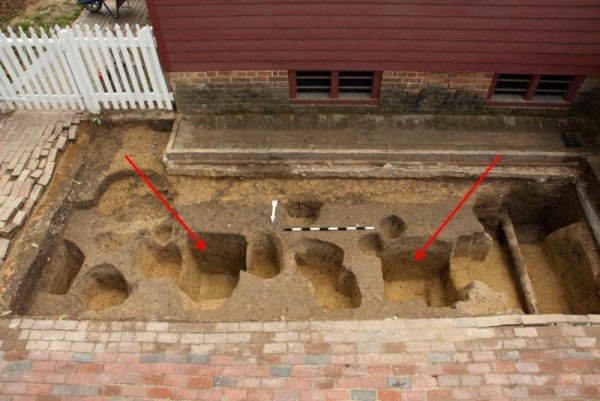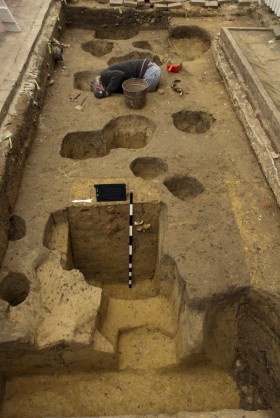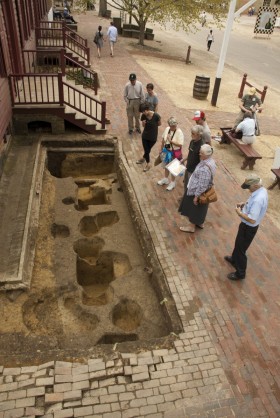
These two substantial postholes are part of an “earthfast” building that pre-dates Wetherburn’s Tavern.
Two weeks ago we profiled our recent investigation of a Revolutionary War era porch across the front of Wetherburn’s Tavern, and hinted at another important discovery made during our fieldwork. We are now ready for the big reveal….wait for it….a previously undocumented early 18th-century building pre-dating Wetherburn’s Tavern!

One of the postholes half-excavated. If you look at the top of the feature, can you see the color difference between the posthole fill and the surrounding soil?
The evidence was subtle at first. No foundation or trash-filled cellar-hole, just a couple of large square postholes — soil stains marking the locations of a pair of vertical wooden posts. At the postholes’ centers, dark stains indicated the positions of 6-inch square wooden posts. To hold the wooden posts in place, both postholes were backfilled with yellow, sandy clay that was visually distinct from the surrounding naturally accumulated soil. The two postholes were very large – roughly 2ft square – and very deep – extending more than 2ft below the surface. The postholes’ surface dimensions and depth were greater than we typically encounter, suggesting that whoever installed the posts took great care to ensure they were held firmly in place. The recovery of English white salt-glazed stoneware – a type of imported ceramic first manufactured in 1720 — from the clay backfill further revealed that the posts were not set in place until sometime after 1720. Finally, the fact that the brick porch piers were built directly on top of the postholes indicated the posts were already removed by the time construction began on the tavern porch.
Williamsburg is riddled with archaeological evidence for fences-lines of small, equally spaced postholes. Less common are larger holes, like the ones recently found at Wetherburn’s Tavern, revealing the outlines of post-in-ground, or earthfast buildings. We know that James Wray, a mid-18th century carpenter, constructed a compound of nine post-in-ground workshops, barns and storage buildings, on lots now occupied by a Merchant Square parking garage. Across the street, on the Bray/Digges site, archaeologists recently found a late 18th -century quarter for enslaved Africans. Perhaps most significantly, an early 18th century post-in-ground warehouse was identified one lot to the east of Wetherburn’s Tavern. None of these structures had foundations. Instead their wood frames were supported by posts set into the ground as anchors for their frames. In contrast to brick buildings, or even wooden buildings on brick foundations, post-in-ground buildings were easily assembled and required a minimum of labor to produce their various structural elements.
The recently discovered posthole evidence points to the construction of “pre-tavern” post-in-ground building, possibly a warehouse like the one found on the adjacent lot. The building’s wooden posts were set into the ground sometime after 1720 and stood no longer than 20 years, as we know Wetherburn’s Tavern was built sometime around 1740 in approximately the same location. The deep holes in which the wooden posts were seated were designed for holding firm heavy timbers that would have also carried the weight of the building’s roof and siding. We still haven’t resolved the overall dimensions of the suspected warehouse, but hope to address that issue later this year.
Our fieldwork at Wetherburn’s Tavern is on a temporary hiatus, but in the months ahead we will return to the site to further investigate the physical evidence of the tavern porch, as well as to search for clue that will help us to better understand the post-in-ground building that pre-dated it.
Contributed by Mark Kostro, Staff Archaeologist.


Mark K. says
Thanks for the kind words Marilyn. You’re absolutely right, it is a great site, and we are very much looking forward to the opportunity to continue the archaeological work there.
Wetherburn’s was one of my 2 or 3 favorite buildings during the 18 years I worked at CW (1995-2013). I took as many school groups through that building as I could. I always had the kids follow the “public/private” furnishings and accommodations throughout the building. It was also a good site for interpreting slave culture in Williamsburg. Greg Brown did some great presentations on the Wetherburn’s archaeological work for my Elderhoster groups. To hear that this wonderful site is still yielding secrets and teaching us more about 18th century Williamsburg is a great treat! Happy hunting - can’t wait to hear more!
Very cool. Assuming there is no evidence of an earlier building burning, thus allowing Weatherburn to build only 20 years later? Can’t wait to hear more.
Mark K. says
Thanks for your comment, Karen. There is no evidence that the post-in-ground building burned. Most likely the building was deliberately taken down as part of the lot’s redevelopment that culminated in the construction of Wetherburn’s Tavern around 1740. Accordingly, we can use the tavern’s construction date (c.1740) as the demolition date for the building that previously occupied the same location.